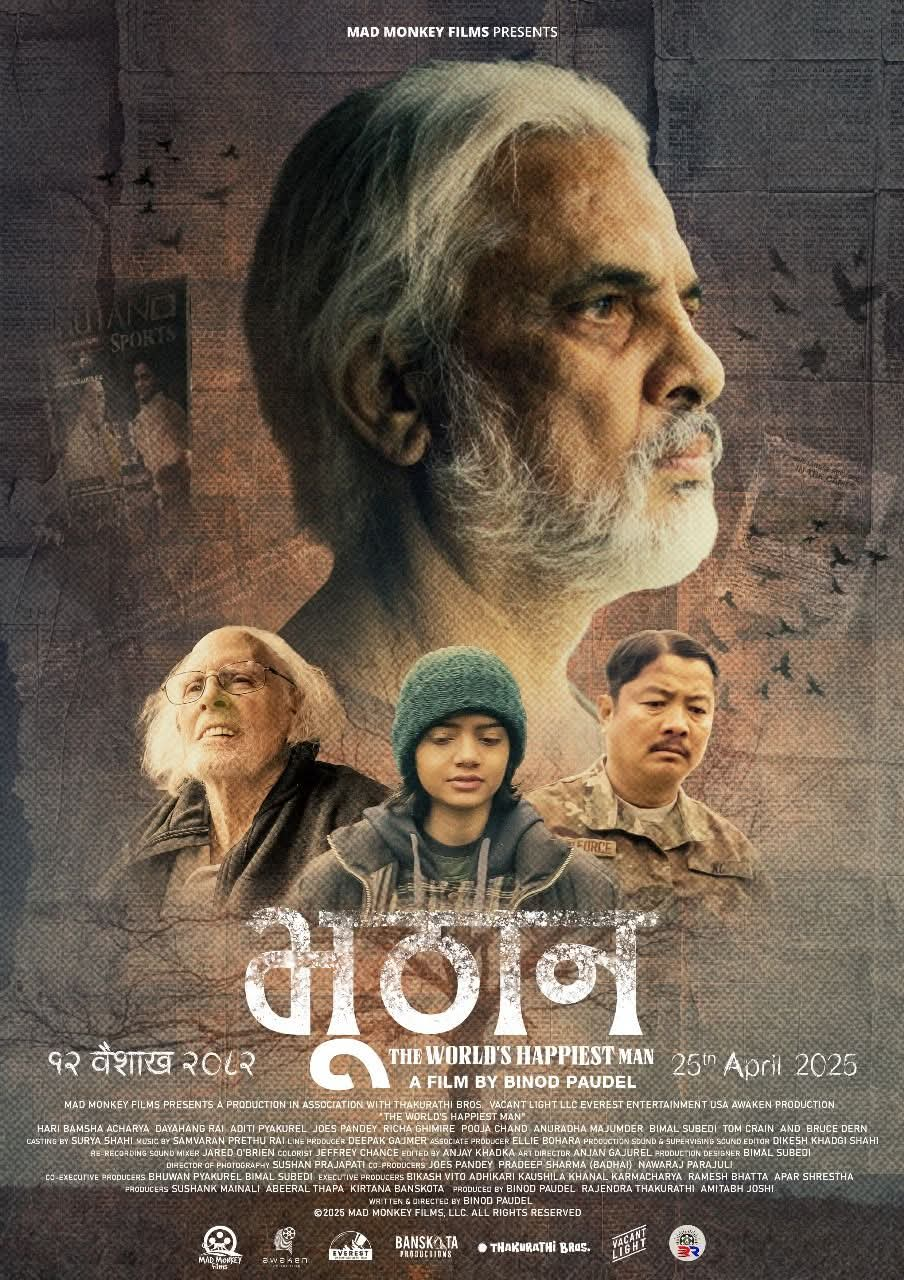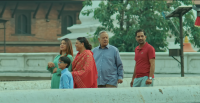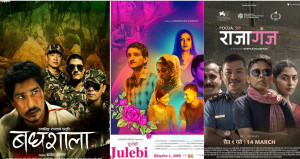Movies
‘Bhuthan’: A touching tale of displacement
The movie blends magical realism with social commentary on themes such as identity and cultural conflict.
Sanskriti Pokharel
The movie ‘Bhuthan—The World’s Happiest Man’, unlike its title, tells the story of a man engulfed by sadness.
The exposition opens with Bishnu (Hari Bansha Acharya) in a phone call, where he shares his pain over being denied a visa to Bhutan for the tenth time. He questions why he cannot return to the country he calls his homeland. This moment sets the tone and introduces the central conflict of the story.
Bhutan’s government refuses to accept Bhutanese refugees back into the country, labelling them as ‘non-nationals and illegal immigrants’. Through Bishnu, the film highlights the struggles of thousands of Nepali-speaking Bhutanese refugees who are denied entry to Bhutan.
The movie, on purpose, is set in Akron, Ohio, the rubber capital of the world.
The name Rubber Capital gave Akron a global identity, a sense of pride, and success. But when the rubber industry collapsed (starting in the 1970s), that pride turned into loss. People today are still living among the ghosts of that era—empty factories, closed company towns, and crumbling union halls.
Sadness often feels heavier when it’s tied to a memory of how good things used to be. The fact that the movie is set in this city adds to the sense of sadness.
The film showcases the city in the hues of grey. No clear blue sky. Just grey clouds looming over the people living there. Not to mention, the fields are barren, and the trees are without leaves. It’s cold and harsh. The ambience of the city mirrors the internal turmoil of the characters.
Sometimes, Bishnu works in a nursery and looks after green plants. One day, as he tends to the plants, news of Bhutanese refugees plays in the background. This scene may illustrate the disparity between reality and Bishnu's ideal life. He dreams of being in Bhutan, a country filled with greenery (symbolised by a nursery), but his current state does not align with his dream.
In one scene, Bishnu tells his granddaughter Gungun (Aditi Pyakurel) about a red silk cotton tree his mother had planted long ago in his hometown. He shares his longing to see it again. He describes the tree as something sacred, an elixir he yearns for.
Gungun, however, finds his words confusing and nonsensical. In the next scene, we see Bishnu standing behind a glass pane that reflects the image of a vibrant, leafy tree. In contrast, the real trees in Arkon are barren and lifeless, much like Bishnu’s own existence there. The lush tree in the reflection symbolises the vitality he associates with his life in Bhutan. A life full of hope and connection. Yet, the reflection feels dreamlike. This vision lives more in his heart and subconscious than in a reality he can reach.
Moreover, the movie also contrasts the Eastern and Western belief systems, which stem from two religions: Hinduism and Christianity.

Although Bishnu lives with his second wife, who is Christian, he is emotionally tied to his first wife. When Bishnu and his second wife are having dinner together, he eats with his hands, but his wife uses a spoon. Though unnoticeable and insignificant, it mirrors the difference between them.
On the other hand, the scenes between Bishnu and his first wife are heartwarming. One such moment, where they share a chatpate, sing together, and grow intimate, feels genuine. Their kiss also feels natural. Spectators in Nepali movies are used to seeing young couples getting intimate. But we are hardly shown the same with older couples. ‘Bhuthan’ deserves praise for bringing something new to the audience.
Additionally, viewers might not immediately recognise the magical realism employed in the movie. It is woven subtly and softly into the storytelling. The burning of a house with crows cawing feels dreamlike rather than literal. Similarly, Bishnu’s face covered with an airless football feels out of nowhere and bizarre.
While the overall story is grounded in real experiences, instances of magical realism enhance the cinematic experience.
The movie also steers its wheel towards social commentary, touching on issues like the rejection of LGBTQ+ relationships and the preference for male children. Through this, it becomes clear that no matter where Nepalis go, traditional mindsets stay with some of them.
‘Bhuthan’ is the kind of movie that is artistic rather than entertaining. Some scenes are akin to painting. Some scenes are too poetic.
It’s rare to see Acharya portray a character burdened by sorrow, as audiences are more used to his comedic performances. But in this film, he reveals a different side of himself—and, as always, delivers a convincing and heartfelt performance.
All the characters in the movie deserve 10/10 for their performances. The presence of Hollywood actor Bruce Dern in the film adds to its grandeur. Debutant Aditi Pyakurel’s acting as Gungun does not feel like acting; it feels natural.
However, the film’s unhurried pace is hard not to notice. Pauses are lingering on certain shots. This slow rhythm enhances its artistic depth. But it may feel tedious to viewers who approach cinema primarily for entertainment rather than introspection. Moreover, due to its nonlinear narrative style, the movie might be incomprehensible and too bizarre for some audiences. It may also feel like a documentary rather than a film.
But take nothing away from ‘Bhuthan’. It is a valuable addition to Nepali cinema. The sound effects, transitions and colour grading in the movie are other elements that are also commendable.
Bhuthan
Director: Binod Paudel
Cast: Hari Bansha Acharya, Aditi Pyakurel, Bruce Dern
Duration: 102 minutes
Year: 2025
Language: Nepali




 8.12°C Kathmandu
8.12°C Kathmandu















